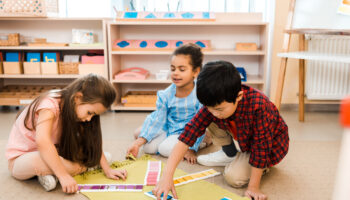Michelle Mallonee Long
Confucius said, “What I hear I forget. What I see I remember. What I do I know.”
Research has proven that the more senses involved in learning, the greater the impression and the longer the retention.
We retain:
10% of what we read
20% of what we hear
39% of what we see
50% of what we see and hear at the same time
70% of what we say and write
90% of what we DO!
(Source: Edgar Dale’s Cone of Experience)
Young children are frequently in motion (running, spinning, jumping, dancing, wiggling, etc.). Rather than spending your time trying to get them to sit still for lessons, think of ways you can use their natural instinct to move to reinforce the concept you are teaching.
These can be as simple as exploring concepts with their bodies:
Direction and Size:
- Do you know what up and down mean? Show me with your body.
- Can you make your body go all the way up? How high can you get?
- Can you go halfway down?
- How small can you make your body? How huge can your body be?
Shapes:
- How round can you be? Can you look like a ball?
- How flat can you make your body?
- Can you look like a flower?
Force:
- Can you stomp? Can you tiptoe?
- Can you move soft like a feather?
- Can you move strong?
- Can you move stiff (like a robot?)
- Can you be as floppy as a rag doll?
Time: (Quick/Slow)
- Can you move like a:
- rabbit -turtle
- race car – old car
- bumble bee – snail
By using these types of questions children can be creative in the way they use their bodies to demonstrate their understanding of the concept. As often as teachers want to join in and participate in activities with the children, be careful to allow them time to show their answers first. When you model what you think the movement should look like, the children will often copy your movements rather than coming up with an idea of their own. Imitation does nothing to foster creativity. You want the emphasis to be on exploration, problem-solving, discovery and self-expression.
Some of the key traits of highly creative individuals in the work force can be developed in early childhood including:
- self- discipline
- perseverance when frustrated
- independence
- tolerance for unclear situations
- willingness to take risks
So get those creative juices flowing, and get those children moving because . . .
“Creativity is intelligence having fun!” – Albert Einstein




